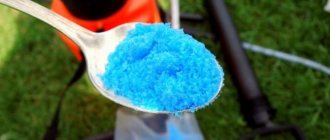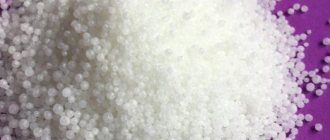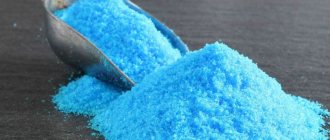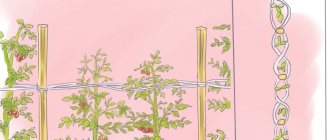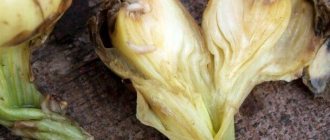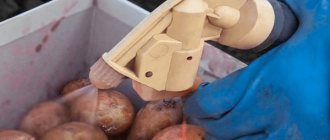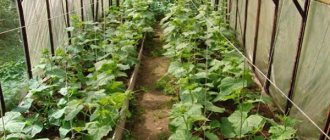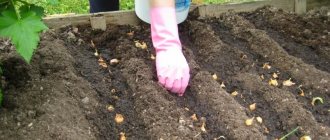Growing herbs and vegetables in a greenhouse is a rather labor-intensive process with many nuances, which are aimed not only at the direct cultivation of crops, but also at caring for the soil and the structure itself. A key role is played by disinfection measures that will help protect plants from diseases and pests during the growing season.
In this article we will look at one of the most effective ways to treat a greenhouse - using copper sulfate. In our article you will find not only the features of spring and autumn treatment, but also tips on preparing and directly using a disinfectant solution.
Why treat a greenhouse?
Many people think, “I built a new greenhouse and nothing will penetrate there. I will receive a good harvest and rejoice.” But this is a fundamentally wrong judgment.
Over time, in any case, pathogenic flora will accumulate: fungal spores, pest larvae. This will lead to a decrease in the harvest or it will be of poor quality, since diseased plants mean bad fruits.
Therefore, it is very important to maintain cleanliness and monitor the condition of the soil and the covering of the greenhouse in order to prevent plant diseases.
It is necessary to carry out regular preventive treatment with an inorganic fungicide - copper sulfate. It offers a comprehensive antiseptic effect and supplies poor soil with copper.
Important: After harvesting, a lot of pathogens may accumulate in the new greenhouse, such as late blight; the lifespan is 3-4 years. Beginners think, “I’ll wash it with soap and water several times, clean it with a cloth and it’ll go away.” Unfortunately, this approach will solve the problem of dirt and unstable bacteria, which, however, are not particularly dangerous for plants. But pathogenic microorganisms will survive the winter and next season they can greatly upset an inexperienced summer resident.
Precautionary measures
It doesn’t matter when copper sulfate is used and what it is used for, the most important thing is safety. At its core, it is an inorganic substance, copper sulfate in the form of a mixture of copper salt and sulfuric acid based on the chemical formula CuSO4∙5H2O. Other qualities:
- Odorless;
- Does not evaporate;
- It is characterized by pronounced hygroscopicity, can absorb and release moisture;
- Use is allowed if diluted in water.
Copper sulfate, due to the peculiarities of its chemical formula, is not as harmful as similar disinfectants created on the basis of organic components.
If the product gets on the skin, rinse it off with water. But, if it turns out to be in the gastrointestinal system, then the situation requires urgent measures:
- Thanks to an enema of a small solution of potassium permanganate, the lower parts of the intestine are washed through the anus: rectum, sigmoid colon;
- A strong laxative is used to immediately remove stool containing copper sulfate. Thus, it will not have time to be strongly absorbed into the body;
- The use of a diuretic is allowed;
- A mechanical method is used to induce a gag reflex, two fingers in the throat, or an appropriate remedy is drunk.
Advice: Copper sulfate is stored in small doses out of the reach of children and animals. But it is better to immediately use it for its intended purpose. During use, wear protective equipment: gloves, mask, goggles, thick clothing.
Disinfection of soil in a greenhouse with potassium permanganate. Truth and myths about potassium permanganate
Potassium permanganate is obtained by oxidation of manganese compounds. The result is a dark purple powder that is highly soluble in water. The substance has strong antiseptic properties. It is used in medicine for washing wounds and the stomach. When used wisely, the substance is harmless to humans and animals.
The antiseptic properties of the powder are useful for garden crops and indoor plants.
Potassium permanganate is used for:
- dressing of seeds, tubers, bulbs;
- soil disinfection;
- disinfection of greenhouses, garden tools, containers for seedlings;
- protection of plants from diseases and pests.
The chemical formula of potassium permanganate is KMnO4, it contains manganese and potassium. Due to the content of these elements in the powder, there is a widespread misconception that potassium permanganate can be used for feeding.
It's a waste of time. Plants absorb manganese only in the form of Mn2+. The element contained in potassium permanganate is not available for green crops. The powder contains negligibly little potassium. To provide plants with an element, you need to make a very concentrated solution that will simply burn them.
There are a lot of recipes on the Internet for solutions with exaggerated dosages of potassium permanganate. There are recommendations for up to 3 tsp. for 10 liters of water. It's practically a black solution that will burn your plants. Therefore, it is better to focus on the color of the solution; it should be pale or bright pink. In this case, very little potassium permanganate is needed - literally up to 5 grains.
The purple color is already a sign of a concentration dangerous for plants. An exception is the processing of equipment and soil. Here solutions can be concentrated.
Potassium permanganate is not compatible with sugar, coal, tannins and other easily oxidizing substances. This must be taken into account during application. Potassium permanganate in combination with these substances provokes a chemical reaction - an explosion.
Reference! Potassium permanganate is used to make drugs. Therefore, its sale in pharmacies is limited to 1-2 packages per customer. The drug can also be purchased at garden or veterinary stores.
How to treat the greenhouse structure?
To ensure a safe place for planting, it is necessary to treat the greenhouse in the spring. Usually a 10-liter solution and 1-2 hours of painstaking work are enough. But before that, it is necessary to inspect the protective structure after winter:
- The integrity and reliability of the structure is checked;
- Contaminants are cleared.
Greenhouse processing process:
- The internal and external parts are cleaned of last year's leaves, tops and other debris. Collected and transferred to another place: materials, tools, household items;
- The interior inspection of the greenhouse continues. Large gaps are sealed with caulk as they can widen and damage the integrity of the structure. Supports are strengthened;
- Using a special product or soap, the upper part of the greenhouse is washed. At this stage, you should not use copper sulfate;
- If the inside is very dirty, then you need to wash everything thoroughly. Now you can pour boiling water over all cleaned surfaces. This will increase the impact of the upcoming treatment with copper sulfate;
- Metal structures are washed with a 9% vinegar solution. If scratches, chips, or other damage are detected, a primer is used to level the surface and secured with paint;
- The structure will dry out overnight. You can prepare a solution of vitriol in advance according to the instructions;
- Wear gloves and other protective items. A standard large bath sponge is dipped into the solution and used to wash internal surfaces and metal supports. But the use of a conventional sprayer is allowed. The latter option can speed up and simplify the work, but it is necessary to spray a copious amount of solution so that it covers the entire surface;
- After 5-6 hours or after overnight, it is necessary to ventilate the greenhouse and repeat the treatment again. During the week, it is worth doing two more disinfection procedures.
How to treat greenhouse soil?
Unlike the design, treatment of the greenhouse soil with copper sulfate is carried out once every 4-5 years, since it cannot be oversaturated with copper. Otherwise, the fruits may be dangerous to eat, and the plants will lose their vitality.
Typically, soil treatment in a greenhouse with copper sulfate is carried out in the fall so that the product does not get on the plants. At this time, a lot of foliage and debris may accumulate, but cleaning is not necessary.
You can spray everything with a solution to kill harmful microorganisms, bacteria, fungal spores and insects.
But it is very important to realize that tillage is different. You cannot use the same concentration as in the case of greenhouse construction. Usually it is necessary to reduce the content of the active substance by half.
Tip: Spraying the bark of fruit trees and shrubs is allowed. But you can’t use it on green parts, because they will die or get damaged.
For soil treatment, a 1% solution is usually used. It is created on the basis of a glass or plastic container. For 10 liters of water you will need approximately 10 grams of chemical. The mixture is used at the rate of 2 liters per 1 square meter.
Complex disinfection of greenhouses
In the case where pests have multiplied in the greenhouse or the cultivation room is heavily infected with a fungal, viral or bacterial infection, there is no time for selectively targeted treatment. It is necessary to use complex preparations with a wide spectrum of action and sacrifice beneficial soil microflora.
Such potent agents include:
- “Bleached lime”;
- “Copper sulfate”;
- “Bordeaux liquid”;
- “Farmayod”;
- "Formalin".
Treatment of polycarbonate greenhouses in the fall with these products is carried out after the removal of plant residues and washing.
Let's learn more about these products and how to dilute them before use.
Copper sulfate
The drug is presented as a blue-blue powder. To prepare the working solution, you need to dissolve 1 tbsp. l. products in 10 liters of water. The resulting solution is poured onto the soil and the walls of the greenhouse structure are sprayed.
To a greater extent, it affects various fungi, and also has a detrimental effect on some bacteria and individual insects.
Farmayod
Essentially, it is an aqueous solution of iodine. To use it, it must be diluted in warm water until a light brown color is obtained. Use the prepared solution to treat the soil and greenhouse structures to remove harmful bacteria.
Instead of Farmayod, you can use potassium permanganate. The result will be similar.
Bleaching powder
Sold in hardware stores in the form of a white powder. It is used in dry form (by spraying onto the soil) against harmful insects and pathogenic bacteria. It has also been established that it gives results in the fight against spider mites. To do this, you need to sprinkle lime not only on the soil, but also on the lower part of the greenhouse walls, after moistening them.
Bordeaux mixture
The preparation consists of equal parts of copper sulfate and slaked lime. Kills fungal and bacterial pathogens and some insects well. The effect is achieved only with proper preparation of the drug.
Preparation is carried out according to the following algorithm:
- take 100 g of copper sulfate and dilute it in 1 liter of hot water;
- The composition is stirred until all the crystals are dissolved, and then the volume is brought to 5 liters with cold water;
- at the same time, in another container, dilute 100 g of unslaked lime in 1 liter of water and wait until it is quenched;
- after this, the volume is also adjusted to 5 l;
- Cool both solutions to 24 degrees and combine them, stirring vigorously;
- when mixing, copper sulfate is poured into the lime solution, resulting in a blue Bordeaux mixture;
On the day of preparation, the resulting product is sprayed onto the greenhouse structures and the soil in it.
Formalin
This is a very potent remedy and is used in exceptional cases when the infection in the greenhouse is very large. The drug kills all living things, including beneficial microflora. Since it is very poisonous, work must be carried out in personal protective equipment and a gas mask.
Treatment is carried out by spraying at the rate of 20 ml of 40% solution per 1 cubic meter of greenhouse. Additionally, you can spray the soil with the preparation for greater effect. After treatment, close the greenhouse for 24 hours and then ventilate.
Freezing out the greenhouse
This is the most environmentally friendly way to combat harmful microflora. To do this, you need to leave the windows and doors of the greenhouse open for the winter.
The freezing method is used to get rid of whiteflies and a number of other pests that remain for the winter.
Sulfur treatment
According to many gardeners, treating a polycarbonate greenhouse with gray in the fall is one of the most effective ways to disinfect greenhouses. The gas released when sulfur burns - sulfuric anhydride - kills all living organisms in a confined space.
The gas will penetrate into all hard-to-reach cracks and even into the soil to a depth of 10 cm, destroying harmful insects and rodents hiding there.
For greater efficiency, sulfur is used together with potassium permanganate according to the following algorithm:
- Fires are lit along the central path along the entire length of the greenhouse, every 6-8 meters.
- Then metal baking sheets with a mixture of sulfur and potassium permanganate are laid out on burning coals. The amount of ingredients is calculated so that per 100 m2 of area there are 2 kg of sulfur and 40 g of potassium permanganate.
- For safety reasons, given the very high toxicity of sulfuric anhydride, the placement of baking sheets with sulfur is carried out from the farthest end of the greenhouse towards the exit from it.
- Under the influence of high temperature, sulfur ignites with abundant release of smoke and sulfuric anhydride. After making sure that the sulfur on all baking sheets has ignited, the doors of the cultivation room are tightly closed and exposed to at least 24 hours.
- At the end of the exposure, the greenhouse will need to be thoroughly ventilated for several days. To do this, open all the doors and windows, creating drafts.
Sulfuric anhydride is very harmful to the human body. Therefore, disinfection work must be carried out in personal protective equipment, and a gas mask or respirator with a gas cartridge should be worn on the face.
Video: features of greenhouse sulfur treatment
Visual videos about the rules and mistakes of using sulfur to treat a greenhouse from the channel “Garden with your own hands.”
Video lesson on greenhouse processing from Yulia Minyaeva
Processing a polycarbonate greenhouse in the fall from the author of the channel “Whether in the garden or in the vegetable garden,” as well as preparing the greenhouse for winter.
When is it more profitable to carry out processing?
It is more correct to carry out the main treatment in the fall based on a temperature of + 10-15 degrees Celsius. If everything is done according to the instructions, only some larvae survive until spring.
After winter, additional preventive treatment is required, but it is ineffective against larvae. Although it also has a positive effect on the quality of the crop.
Spring treatment can help get rid of the most persistent insects, microorganisms and pathogenic flora in general. Therefore, you should not neglect this matter.
Now we have figured out the benefits of using copper sulfate on the surface of the greenhouse and in the process of disinfecting the soil. But due to the strong toxic effects, you should not use a pure chemical; it is better to rely on Bordeaux or Burgundy liquid.
Treating the land with copper sulfate
After all the garbage has been removed from the ground, you can begin to directly process it. First of all, you should remember that you should not spend a lot of effort on breaking up clods of earth and leveling them.
Thanks to frosts in winter, much more of both weed seeds and harmful larvae will die in them.
After this, the following types of fertilizer compositions are introduced into the soil rock, which are taken per square meter:
- Potassium-based fertilizers from twenty grams to twenty-five;
- Superphosphate in the amount of thirty to forty grams;
- Humus will require from four to six kilograms.
